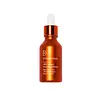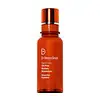What's inside
What's inside
 Key Ingredients
Key Ingredients

 Benefits
Benefits

 Concerns
Concerns

 Ingredients Side-by-side
Ingredients Side-by-side

Water
Skin ConditioningDipropylene Glycol
HumectantAscorbic Acid
AntioxidantDimethyl Isosorbide
SolventRicinoleth-40
CleansingAminomethyl Propanol
BufferingLactic Acid
BufferingTocopherol
AntioxidantGlycyrrhiza Glabra Root Extract
BleachingFerulic Acid
AntimicrobialMorus Alba Fruit Extract
AntioxidantSodium Hyaluronate
HumectantGlycolic Acid
BufferingAdenosine
Skin ConditioningGlycerin
HumectantPhenoxyethanol
PreservativeWater
Skin ConditioningSqualane
EmollientGlycerin
Humectant3-O-Ethyl Ascorbic Acid
Skin ConditioningTetrahexyldecyl Ascorbate
AntioxidantAscorbic Acid
AntioxidantLactic Acid
BufferingSilybum Marianum Fruit Extract
Skin ConditioningNiacinamide
SmoothingCentella Asiatica Extract
CleansingCeramide Ng
Skin ConditioningSuperoxide Dismutase
AntioxidantQuercetin
AntioxidantPhospholipids
Skin ConditioningSodium Hyaluronate
HumectantHydrolyzed Sodium Hyaluronate
Skin ConditioningSodium Carboxymethyl Beta-Glucan
CleansingInonotus Obliquus Extract
Skin ConditioningSaccharide Isomerate
HumectantFerulic Acid
AntimicrobialUbiquinone
AntioxidantSoy Isoflavones
Skin ConditioningAloe Barbadensis Leaf Juice
Skin ConditioningPhytosphingosine
Skin ConditioningLeuconostoc/Radish Root Ferment Filtrate
AntimicrobialMethyl Gluceth-20
HumectantPropylene Glycol
HumectantSodium PCA
HumectantMyristyl Myristate
EmollientButylene Glycol
HumectantPolyglyceryl-10 Laurate
Skin ConditioningPentylene Glycol
Skin ConditioningCaprylyl Glycol
EmollientAdenosine
Skin ConditioningCarbomer
Emulsion StabilisingCetearyl Olivate
Polyacrylate Crosspolymer-6
Emulsion StabilisingLauryl Laurate
Skin ConditioningSodium Hydroxide
BufferingPotassium Hydroxide
BufferingSodium Glycolate
BufferingC13-15 Alkane
SolventSorbitan Olivate
EmulsifyingPhytic Acid
Citric Acid
BufferingSodium Citrate
BufferingTetrasodium Glutamate Diacetate
Pentasodium Pentetate
Camellia Sinensis Leaf Extract
AntimicrobialCucumis Sativus Fruit Extract
EmollientTriethyl Citrate
MaskingLavandula Angustifolia Flower/Leaf/Stem Extract
MaskingElettaria Cardamomum Seed Extract
PerfumingPyrus Malus Fruit Extract
Skin ConditioningRubus Idaeus Fruit Extract
AstringentCananga Odorata Flower Extract
PerfumingCitrus Aurantium Bergamia Fruit Extract
Skin ConditioningCitrus Aurantium Amara Flower Extract
RefreshingCoffea Arabica Seed Extract
MaskingCucumis Melo Fruit Extract
Skin ConditioningCupressus Sempervirens Leaf/Stem Extract
Skin ConditioningFucus Vesiculosus Extract
EmollientJasminum Officinale Flower Extract
MaskingRose Extract
Skin ConditioningRosmarinus Officinalis Leaf Extract
AntimicrobialSalvia Officinalis Leaf Extract
CleansingSantalum Album Wood Extract
PerfumingPhenoxyethanol
PreservativeSorbic Acid
PreservativePotassium Sorbate
PreservativeWater, Squalane, Glycerin, 3-O-Ethyl Ascorbic Acid, Tetrahexyldecyl Ascorbate, Ascorbic Acid, Lactic Acid, Silybum Marianum Fruit Extract, Niacinamide, Centella Asiatica Extract, Ceramide Ng, Superoxide Dismutase, Quercetin, Phospholipids, Sodium Hyaluronate, Hydrolyzed Sodium Hyaluronate, Sodium Carboxymethyl Beta-Glucan, Inonotus Obliquus Extract, Saccharide Isomerate, Ferulic Acid, Ubiquinone, Soy Isoflavones, Aloe Barbadensis Leaf Juice, Phytosphingosine, Leuconostoc/Radish Root Ferment Filtrate, Methyl Gluceth-20, Propylene Glycol, Sodium PCA, Myristyl Myristate, Butylene Glycol, Polyglyceryl-10 Laurate, Pentylene Glycol, Caprylyl Glycol, Adenosine, Carbomer, Cetearyl Olivate, Polyacrylate Crosspolymer-6, Lauryl Laurate, Sodium Hydroxide, Potassium Hydroxide, Sodium Glycolate, C13-15 Alkane, Sorbitan Olivate, Phytic Acid, Citric Acid, Sodium Citrate, Tetrasodium Glutamate Diacetate, Pentasodium Pentetate, Camellia Sinensis Leaf Extract, Cucumis Sativus Fruit Extract, Triethyl Citrate, Lavandula Angustifolia Flower/Leaf/Stem Extract, Elettaria Cardamomum Seed Extract, Pyrus Malus Fruit Extract, Rubus Idaeus Fruit Extract, Cananga Odorata Flower Extract, Citrus Aurantium Bergamia Fruit Extract, Citrus Aurantium Amara Flower Extract, Coffea Arabica Seed Extract, Cucumis Melo Fruit Extract, Cupressus Sempervirens Leaf/Stem Extract, Fucus Vesiculosus Extract, Jasminum Officinale Flower Extract, Rose Extract, Rosmarinus Officinalis Leaf Extract, Salvia Officinalis Leaf Extract, Santalum Album Wood Extract, Phenoxyethanol, Sorbic Acid, Potassium Sorbate
 Reviews
Reviews

Ingredients Explained
These ingredients are found in both products.
Ingredients higher up in an ingredient list are typically present in a larger amount.
Adenosine is in every living organism. It is one of four components in nucleic acids that helps store our DNA.
Adenosine has many benefits when used. These benefits include hydrating the skin, smoothing skin, and reducing wrinkles. Once applied, adenosine increases collagen production. It also helps with improving firmness and tissue repair.
Studies have found adenosine may also help with wound healing.
In skincare products, Adenosine is usually derived from yeast.
Learn more about AdenosineAscorbic Acid is is pure Vitamin C. This form makes up the largest amount of vitamin C found naturally in our skin.
Not only is vitamin C great for your overall health and immune system, it also has plenty of benefits on your skin.
Vitamin C is best used for brightening skin. It improves dark spots, acne scars, and hyperpigmentation. This is because it blocks the process of skin darkening when exposed to UV.
Remember: Vitamin C should not replace sunscreen!
Your skin uses vitamin C to build collagen. Collagen is one key component in having a strong skin barrier and plump skin. Vitamin C also plays a role in regulating collagen, thus making it effective in improving wrinkles and fine lines.
Ascorbic acid shows potent antioxidant activity. As an antioxidant, it helps fight free-radicals. Free-radicals are molecules that may damage your skin cells. These antioxidants also protect skin against UV damage.
The best formulations include Vitamin E and/or ferulic acid. These two ingredients help stabilize and provide a boost in the benefits of ascorbic acid. This is because ascorbic acid becomes unstable when exposed to UV and air. In fact, you can tell your ascorbic acid has oxidized when it turns an orange-yellow color.
Ascorbic acid is generally compatible with other ingredients. However, using ascorbic acid with other active ingredients might cause irritation. Two ingredients: copper ions and benzoyl peroxide, will inactivate ascorbic acid completely.
Read more about other types of Vitamin C:
Foods rich with vitamin C include oranges, strawberries, broccoli, bell peppers, and more. When consuming Vitamin C, your skin receives a portion of the nutrients.
Learn more about Ascorbic AcidFerulic Acid is a plant based antioxidant. By fighting free-radicals, ferulic acid can help reduce the formation of fine lines and hyperpigmentation.
When used with Vitamin C, Ferulic Acid has shown to prevent Vitamin C from breaking down. In other words, it acts as a stabilizer.
Ferulic Acid is sometimes used to preserve food. Foods containing Ferulic Acid include: oats, rice, eggplant, citrus.
In medicine, Ferulic Acid is being studied for helping with diabetes, Alzheimer's, and cardiovascular diseases.
Learn more about Ferulic AcidGlycerin is already naturally found in your skin. It helps moisturize and protect your skin.
A study from 2016 found glycerin to be more effective as a humectant than AHAs and hyaluronic acid.
As a humectant, it helps the skin stay hydrated by pulling moisture to your skin. The low molecular weight of glycerin allows it to pull moisture into the deeper layers of your skin.
Hydrated skin improves your skin barrier; Your skin barrier helps protect against irritants and bacteria.
Glycerin has also been found to have antimicrobial and antiviral properties. Due to these properties, glycerin is often used in wound and burn treatments.
In cosmetics, glycerin is usually derived from plants such as soybean or palm. However, it can also be sourced from animals, such as tallow or animal fat.
This ingredient is organic, colorless, odorless, and non-toxic.
Glycerin is the name for this ingredient in American English. British English uses Glycerol/Glycerine.
Learn more about GlycerinLactic Acid is another well-loved alpha hydroxy acid (AHA). It is gentler than glycolic acid but still highly effective.
Its main role is to exfoliate the surface of the skin by loosening the “glue” that holds dead skin cells together. Shedding those old cells leads to smoother, softer, and more even-toned skin.
Because lactic acid molecules are larger than glycolic acid, they don’t penetrate as deeply. This means they’re less likely to sting or irritate, making it a great choice for beginners or those with sensitive skin.
Like glycolic acid, it can:
Lactic acid also acts as a humectant (like hyaluronic acid). It can draw water into the skin to improve hydration and also plays a role in the skin's natural moisturizing factor (NMF) in the form of sodium lactate.
Studies show it can boost ceramide production to strengthen the skin barrier and even help balance the skin’s microbiome.
To get results, choose products with a pH between 3-4.
Lower strengths (5-12%) focus on surface exfoliation; higher strengths (12% and up) can reach deeper in the dermis (deeper, supportive layer) to improve skin texture and firmness over time.
Though it was originally derived from milk, most modern lactic acid used in skincare is vegan. It is made through non-dairy fermentation to create a bio-identical and stable form suitable for all formulations.
When lactic acid shows up near the end of an ingredient list, it usually means the brand added just a tiny amount to adjust the product’s pH.
Legend has it that Cleopatra used to bathe in sour milk to help reduce wrinkles.
Lactic acid is truly a gentle multitasker: it exfoliates, hydrates, strengthens, and brightens. It's a great ingredient for giving your skin a smooth, glowing, and healthy look without the harshness of stronger acids.
Read more about some other popular AHA's here:
Learn more about Lactic AcidPhenoxyethanol is a preservative that has germicide, antimicrobial, and aromatic properties. Studies show that phenoxyethanol can prevent microbial growth. By itself, it has a scent that is similar to that of a rose.
It's often used in formulations along with Caprylyl Glycol to preserve the shelf life of products.
Sodium Hyaluronate is hyaluronic acid's salt form. It is commonly derived from the sodium salt of hyaluronic acid.
Like hyaluronic acid, it is great at holding water and acts as a humectant. This makes it a great skin hydrating ingredient.
Sodium Hyaluronate is naturally occurring in our bodies and is mostly found in eye fluid and joints.
These are some other common types of Hyaluronic Acid:
Learn more about Sodium HyaluronateWater. It's the most common cosmetic ingredient of all. You'll usually see it at the top of ingredient lists, meaning that it makes up the largest part of the product.
So why is it so popular? Water most often acts as a solvent - this means that it helps dissolve other ingredients into the formulation.
You'll also recognize water as that liquid we all need to stay alive. If you see this, drink a glass of water. Stay hydrated!
Learn more about Water